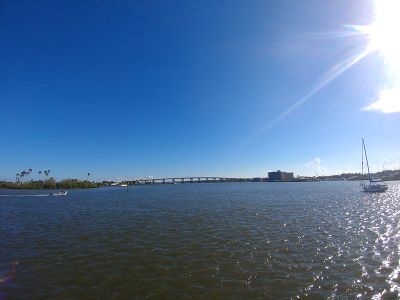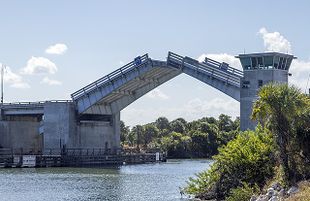Mosquito Lagoon: Difference between revisions
mNo edit summary |
mNo edit summary |
||
| Line 5: | Line 5: | ||
<div class="irlcontenttop"> | <div class="irlcontenttop"> | ||
[[Mosquito Lagoon]] is a 28 mile long, 36,000 acre, bar-built lagoon located in [[:Category:Brevard County|Brevard]] and [[:Category:Volusia County|Volusia]] counties on the east coast of Florida. | [[Mosquito Lagoon]] is a 28 mile long, 36,000 acre, bar-built lagoon located in [[:Category:Brevard County|Brevard]] and [[:Category:Volusia County|Volusia]] counties on the east coast of Florida. | ||
Recognized by the EPA National Estuary Program as an ''Estuary of National Significance'', Mosquito Lagoon is one of three main lagoons in the [[Indian River Lagoon Estuary|Indian River Lagoon National Estuary]]. It is an acclaimed spotted seatrout and red drum fishery, and a popular destination for anglers, kayakers, and wildlife watchers. | Recognized by the EPA National Estuary Program as an ''Estuary of National Significance'', Mosquito Lagoon is one of three main lagoons in the [[Indian River Lagoon Estuary|Indian River Lagoon National Estuary]]. It is an acclaimed spotted seatrout and red drum fishery, and a popular destination for anglers, kayakers, and wildlife watchers. | ||
| Line 23: | Line 23: | ||
<div class="irlcontentmiddle"> | <div class="irlcontentmiddle"> | ||
==Geology== | |||
Development of the barrier island forming the eastern boundary of Mosquito Lagoon began approximately 7,000 years ago. | |||
Five tidal inlets once connected the lagoon with the Atlantic Ocean (Mehta and Brooks 1973). These inlets were located at the mangrove island clusters found between Max Hoeck Creek and Turtle Mound. The inlets appear to be older in age as you progress southward. The last invasion of new quartz sand to the lagoon occurred about 1500 years ago and so the youngest inlet was at Turtle Mound and dates to approximately 500 A.D. The geological strata for these old inlet areas contain oysters indicating that the area was open to tidal flushing. | |||
Mosquito Lagoon was not connected to the Indian River Lagoon until the construction of [[Haulover canal]] in 1854 (Snelson 1983).<ref name="nasaML" /> | |||
==Ecosystem== | ==Ecosystem== | ||
[[File:Mosquitolagoon.jpg|400px|thumb|right|Manatees in Mosquito Lagoon]] | [[File:Mosquitolagoon.jpg|400px|thumb|right|Manatees in Mosquito Lagoon]] | ||
Revision as of 19:18, October 2, 2020
Mosquito Lagoon is one of the least developed regions on the east coast of Florida.
Mosquito Lagoon is a 28 mile long, 36,000 acre, bar-built lagoon located in Brevard and Volusia counties on the east coast of Florida.
Recognized by the EPA National Estuary Program as an Estuary of National Significance, Mosquito Lagoon is one of three main lagoons in the Indian River Lagoon National Estuary. It is an acclaimed spotted seatrout and red drum fishery, and a popular destination for anglers, kayakers, and wildlife watchers.
Mosquito Lagoon is one of the largest undeveloped and primitive coastal zones remaining on Florida's East Coast. Unfamiliar boaters are advised to carry a GPS device when venturing past the marked channels.
Location
Mosquito Lagoon extends from the Ponce de Leon Inlet to a point north of Cape Canaveral. It connects to the Indian River via the Haulover Canal at Allenhurst.
Coordinates: 28°47'51.1"N 80°46'45.2"W
GIS: (28.797532, -80.779221)
Geology
Development of the barrier island forming the eastern boundary of Mosquito Lagoon began approximately 7,000 years ago.
Five tidal inlets once connected the lagoon with the Atlantic Ocean (Mehta and Brooks 1973). These inlets were located at the mangrove island clusters found between Max Hoeck Creek and Turtle Mound. The inlets appear to be older in age as you progress southward. The last invasion of new quartz sand to the lagoon occurred about 1500 years ago and so the youngest inlet was at Turtle Mound and dates to approximately 500 A.D. The geological strata for these old inlet areas contain oysters indicating that the area was open to tidal flushing.
Mosquito Lagoon was not connected to the Indian River Lagoon until the construction of Haulover canal in 1854 (Snelson 1983).[1]
Ecosystem
Mosquito Lagoon is located in a transition zone between the temperate province to the north and the warm subtropical province to the south. Its temperate climate and numerous habitats attract an abundance of plant and animal species. This unique environmental setting makes Mosquito Lagoon part of one of the most diverse estuarine areas in the United States.
Mosquito Lagoon is dominated by shallow flats (less than 1.5 m) that support the growth of submerged aquatic vegetation including manatee grass,(Syringodium filiforme), shoal grass (Halodule wrightii), widgeon grass (Ruppia maritima), and various macroalgae such as Gracilaria, Caulerpa, Sargassum, and Acanthophora.
Shorelines of the system are dominated by white (Laguncularia racemosa) and black (Avicennia germinans) mangrove. This region is the mangrove's northern range limit and occasional winter freezes have significantly impacted their populations.
Fauna in the lagoon is also dominated by species common to the Carolinian Province such as mullet (Mugil cephalus), spotted sea trout (Cynoscion nebulosus), red drum (Sciaenops ocellatus), sea catfish (Arius felis), and blue crabs (Callinectes sapidus) to name a few. Subtropical species are present but are less prevalent than in the southern portion of the Indian River Lagoon System.[1]
Management
About 82% of Mosquito Lagoon is on federal property and co-managed by federal agencies.
About 65% of the lagoon lies on Kennedy Space Center property and is managed by the Fish and Wildlife Service (FWS) as part of the Merritt Island National Wildlife Refuge. Another 17% is managed by the National Park Service as part of Canaveral National Seashore.
Additionally, the lagoon's Haulover Canal and Bridge are maintained and operated by the U.S. Army Corps of Engineers (USACE) as a part of the Intracoastal Waterway (ICW).
Mosquito Lagoon is recognized as an "Outstanding Florida Water", and the remaining non-federal property in the northern area is managed by Florida's Fish and Wildlife Conservation Commission (FWC) as the Mosquito Lagoon Aquatic Preserve.
| Waterway: Mosquito Lagoon | Road: SR3 | |||
| City: Allenhurst | County: Brevard | |||
| Type: Bascule Double Leaf | Builder:McCormick and Sons | |||
| DOT: 703004 | H: 27' | Built: 1964-01-01 | ||
Location: (28.73634,-80.75459)
Tap for active map.
| ||||
| 1964 U.S. Army Corps of Engineers' Bascule double leaf drawbridge crossing Florida SR3 (N Courtney Parkway) over the Haulover Canal in the Merritt Island Wildlife Refuge. Article | ||||


